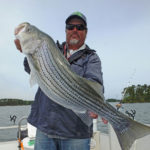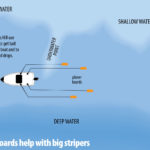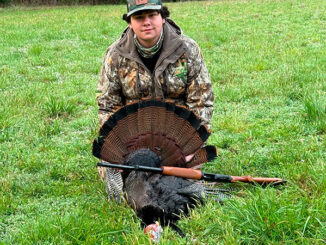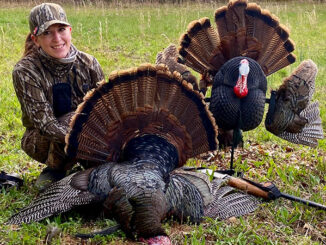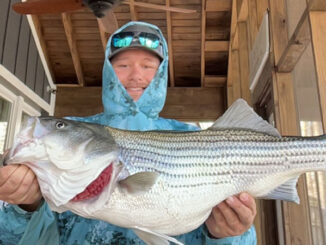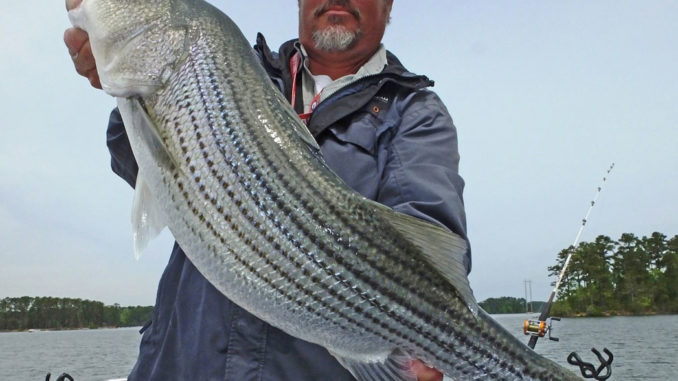
Clarks Hill Lake is a great striper fishery, and for trophy fish, there’s no time better than spring, according to these two guides.
Getting your string stretch by a trophy striper can happen year-round at Clarks Hill Lake, aka Lake Thurmond, but if you want to boost your odds for trophy fish, go now.
Guide Tony Shepherd, 48, a retired U.S. Army paratrooper who has fished the lake since he was 16, said the late-March and April time period provides the opportunity for top-end sized fish, with the bonus of fast-paced action.
“It’s prime time for great striper and hybrid fishing,” said Shepherd (706-210-3474). “It’s not uncommon to catch a 3-pound fish, followed immediately by a 30-pound striper, from the same spot. We’ll sometimes have a couple of huge stripers hooked at the same time, creating a serious adrenalin surge.”
Shepherd said exceptional fishing like this often come with a catch to making that trophy catch.
“When striper fishing, forage is always the key,” he said. “At this time of the year, the herring are in spawning mode, and day-to-day, their location can be anywhere from shallow shoals and points to deep water.”
Shepherd said the movement of forage creates a daily fish-finding process. When baitfish are shallow, stripers will be around them, and when they back off into deep water, the stripers will follow suit. Weather patterns and changing water temperature have a profound impact on where the forage and fish are found.
“I love the challenge and opportunity this time of year offers,” he said. “Patterns occasionally last a few days, but my mindset is (that) it will be a new game every day, and we’ll work out the process.”
Shepherd said all sorts of different underwater topographic features are found at Clarks Hill, and they serve as potential striper and hybrid targets.
“Early on, a lot of the fishing is in the major creeks and tributaries, but as we progress, forage and fish move toward the main channel and deeper water,” he said. “The shallow shoals and points where herring may spawn are great when that occurs, making those targets priority No. 1 for the stripers and hybrids. But the herring spawn isn’t an ongoing event, so it’s merely one piece of the fish-catching puzzle.”
Brad Sasser, a 36-year-old second-generation Clarks Hill guide, also touts April as a season for quality stripers, especially when they’re on a solid pattern when herring migrate shallow to spawn.
“I fish the hard-bottomed, secondary points in the major creeks and tributaries because that’s where herring often prefer to spawn,” he said. “When herring move in the stripers and hybrids will be on these points hammering the forage.”
Sasser (706-589-5468) said the exact time for spawning varies depending on water temperatures. He begins checking likely points in mid-March, but it may be into April in some years. Plus, strong fronts can shut the process down for a few days.
Pulling planer boards is a key, and the process adds significantly to the catch rate of big stripers.
“My preferred bait is live, 6-inch herring; they work great with a mid-sized planer board,” Sasser said. “Fishing shallow water, I’ll free-line herring behind the board. Using a planer board, I can stay well off of a shallow shoal or point where herring are spawning and not spook the bait or stripers. I can effectively present the bait right on top of the fish, even in the generally very clear shallow water.”
Shepherd said other patterns are essential, because herring don’t spawn continuously, and if they’re not spawning, they’ll move toward deeper water. Other prime April targets include long, sloping points, channel ledges, humps and shallow flats near deeper water. As the season progresses, fish and forage will move toward the main channel area and out of big creeks and tributaries.
Regardless of the underwater target, he said having forage nearby remains crucial, and mapping out a daily strategy involves heavy reliance on his graph.
“Patterns are typically short-lived this time of the year,” he said. “Often, patterns change after a few hours, depending on weather patterns, but when on a good pattern, the action is fast. Occasionally, I’ll key in on something, and I’ll be able to tap into it for multiple days. With warming water as spring progresses, patterns will change, and we have to adapt.”
Shepherd said when a front blows through, stripers will often pushed out of a current pattern and suspend over much deeper water, often 45 to 50 feet deep, but stripers can still be caught fairly shallow over this deeper water, especially if the forage is suspended.
“One frequent (April) pattern is fishing relatively shallow in the water column, but targeting stripers suspended over much deeper water,” he said. “At times, I may be fishing only 5 to 10 feet deep for suspended stripers, but they may be holding over 45 feet or more of water.”
“When my graphs marks a lot of stripers suspended, they’re likely taking advantage of suspended forage,” he said. “A typical example is stripers may be suspended at only 10 to 20 feet deep over 45 feet of water. In this case, I work planer boards with herring well behind them, so the bait works quite shallow. I’ll fish the boards at least 50 feet behind the boat and use the electric motor to move very slowly, because the water temperature is still fairly cool. This can be a great tactic for big stripers.”
Shepherd said fish may be at any depth in the water column, but when they see the bright flash of a herring near the surface, they’ll often go into overdrive to come up and slam it.
“Finding stripers at Clarks Hill this time of year is simply a game of following and finding a moving target and doing so repeatedly, in a sense,” he said. “Experience helps me a lot, but I also rely heavily on my graph, particularly in this type instance. With the graph I can see fish and forage suspended over deep water, and I can quickly lock onto a pattern.”
Many Clark Hill guides use similar tackle, but each will have their own twists. Shepherd said he prefers 7½-foot, medium-light action Ugly Stiks with ABU 6500 reels loaded with 20-pound monofilament with a 2½-foot leader of 12-pound Seagar fluorocarbon.
“The fluorocarbon line is absolutely critical for the leader because of invisibility and abrasion resistance,” he said. “I prefer small circle hooks so the herring will have more mobility, and 1/0 Owner light circle hooks are very effective.”
Sasser said the water in Clarks Hill is usually clear in April, and plays into using planer boards; they get baits away from his boat.
“Also, I like a bit of chop on the water to diffuse light; (it) makes the fish more likely to feed more aggressively,” he said. “Too much wind obviously makes boat control very difficult. Some wind makes presentation easy and much more effective, but too strong creates boat-control issues, so optimum bait presentation is difficult to maintain.”
Sasser said he’s on the move most of April, pulling planer boards with his electric motor. When severe wind conditions are present, he’s forced to wind drift. Wind socks slow the speed of his boat, and he can still make an effective presentation.
“I’ll figure out the best drift pattern in advance, based on what I see on the graph,” he said. “I prefer to target a spot where I can make a long drift, and that’s usually not difficult to find. Boat control is the key, and being able to use the electric motor to adjust speed and direction is preferred, but we’ll still make good catches on windy days. I just have to adapt to best use the conditions to my favor.”
Shepherd’s summary of the most-essential things for April success is simple.
“First, begin with quality bait and keeping fresh bait on the hook,” he said. “Next is staying flexible in your presentation and not assuming that what happened yesterday will be mirrored today. Just because yesterday’s action was wide open in only 10 feet of water doesn’t mean we won’t have a totally different situation today. It’s April; patterns can change fast.”
Shepherd said relying on his graph to determine not only where the fish are is crucial, but he uses it as a tool to determine the pattern for the day. Finally, pay attention to natural surroundings for clues. He said when he sees birds acting fishy, he’ll often check that spot with the graph.
“I read bird patterns to search for forage,” he said. “We know gulls are great for identifying where forage and fish are located. Loons dive down to get herring. Watch for things like that; they’re good clues.”
“Over the course of a day, these type things help in the fish-finding process,” he said. “Sometimes, I check an area like this, the graph lights up with fish and forage, and it’s game on. Then, I’ll go find other similar areas and will often find more fish in similar areas without birds or other clues present.”
Stripers may be a moving target during April, but these tactics can guide you to the string-stretching stripers at Clarks Hill Lake.
DESTINATION INFORMATION
HOW TO GET THERE — Clarks Hill, aka Lake Thurmond, lies downstream from Hartwell and Russell on the Savannah River. On the South Carolina side, the lake spans from just below Calhoun Falls down to the town of Clarks Hill. SC 28 parallels the length of the lake between these two towns. The U.S. Army Corps of Engineers maintains the majority of the public boat ramps on the lake; locate them here: www.sas.usace.army.mil/lakes/thurmond.
WHEN TO GO — Late March through April is an unmatched time for catching trophy stripers and hybrids in Clarks Hill Lake.
BEST TECHNIQUES — Pull live herring behind planer boards or on free lines, especially when stripers are shallow, mirroring the movement of spawning herring. Look on long, tapering points. Fish may also suspend over deep water around schools of bait.
FISHING INFO/GUIDES — Tony Shepherd, Little River Guide Service, (706-210-3474), www.littleriverguideservice.net; Brad Sasser, Sasser’s Guide Service, 706-589-5468, www.williamsasserfishing.com; Herring Hut, Clarks Hill, S.C., 864-333-2000; Palmetto Angler, McCormick, S.C., 864-852-3373. See also Guides and Charters in Classifieds.
ACCOMMODATIONS — For cabins, hotel rooms and campsights, Hickory Knob State Park, www.southcarolinaparks.com/hickoryknob/introduction; McCormick County Visitors Center, 864-852-3216, mccormickscchamber.org.
MAPS — Navionics Electronic Charts, 800-848-5896, www.navionics.com. Delorme S.C. Atlas and Gazetteer, 800-561-5105, www.delorme.com; Fishing Hot Spots, 800-ALL-MAPS, www.fishinghotspots.com; Kingfisher Maps, 800-326-0257, www.kfmaps.com.

